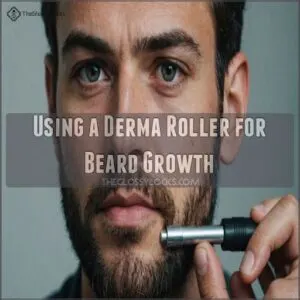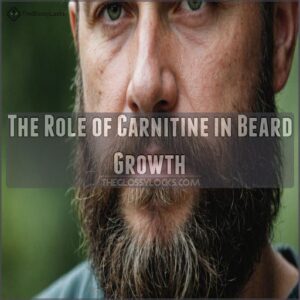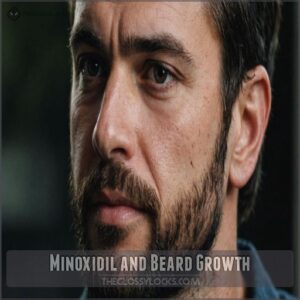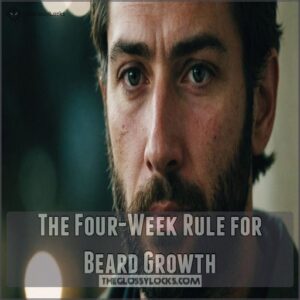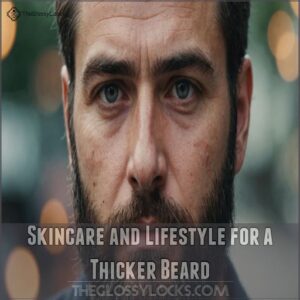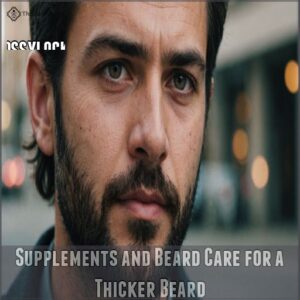This site is supported by our readers. We may earn a commission, at no cost to you, if you purchase through links.
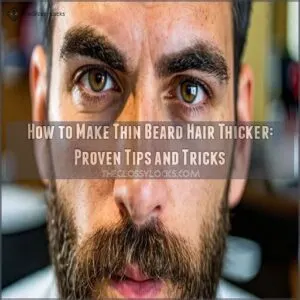 You can make your thin beard hair thicker through proven tactics that work from the inside out.
You can make your thin beard hair thicker through proven tactics that work from the inside out.
Start with the basics: proper nutrition (think protein and biotin), regular exercise, and quality sleep to boost testosterone naturally.
While you’re building that foundation, use a high-quality beard oil to soften existing hair and stimulate follicles.
Combine this with strategic trimming – keeping your beard at the best length where it appears fullest.
For more advanced results, consider tools like derma rolling or supplements like L-carnitine.
Some guys even swear by incorporating a balanced diet rich in protein, vitamins, and minerals, similar to those recommended for growing a Viking beard, to promote healthy hair growth. Some guys even swear by "beard training" techniques that literally reshape how your facial hair grows.
Table Of Contents
- Key Takeaways
- Factors Affecting Beard Thickness
- Enhancing Beard Growth Through Micro-needling
- The Role of Carnitine in Beard Growth
- Minoxidil and Beard Growth
- Nutrition and Beard Growth
- The Four-Week Rule for Beard Growth
- Skincare and Lifestyle for a Thicker Beard
- Supplements and Beard Care for a Thicker Beard
- Options for Thicker Beards in Older Men
- Frequently Asked Questions (FAQs)
- How to grow a thicker beard?
- What are the remedies for hair growth and hair thickness?
- How do you thicken a beard?
- How to style a thin beard?
- Can a thin beard grow thick?
- How do I make my beard hair thicker?
- Why my beard hairs are so thin?
- How can I make my beard less thin?
- Can beard dye make thin facial hair appear thicker?
- Does using a beard brush stimulate growth?
- How do different beard styles affect thickness appearance?
- What role do temperatures play in beard growth?
- Can scalp hair products help thicken beard hair?
- Conclusion
Key Takeaways
- Focus on proper nutrition, including protein, biotin, and essential vitamins, to support beard growth from the inside out.
- Implement a consistent skincare routine, including cleansing, exfoliating, and moisturizing, to create an optimal environment for beard growth.
- Consider using proven treatments like minoxidil or micro-needling to stimulate hair follicles and increase beard density.
- Be patient and give your beard at least four weeks to show results, while maintaining a healthy lifestyle that includes regular exercise and stress reduction.
Factors Affecting Beard Thickness
Before we jump into tips and tricks, let’s understand what influences your beard’s thickness.
Genetics, your hormone levels, and even the size of your hair follicles all play a role in determining how full and lush your beard will grow, so let’s explore these key influences.
Hair Follicle Size and Density
Feeling like your beard’s playing hard to get? It’s all about hair follicle size and density. Larger follicles, thanks to good genes and testosterone, mean thicker hair. Dense beards create a full look. Here’s the breakdown:
- Genetics influences follicle size
- Testosterone boosts thickness
- Blood flow promotes growth
- Hair growth cycle matters
- Balanced diet is key
Beard Length and Color
Shifting from density, you’ll find that beard length and color can transform your beard game.
A longer beard enhances thickness, and darker hues make it pop.
Ever considered a hint of dye?
It’s fun and effective.
Just trim smartly to shape it right!
| Aspect | Effect on Beard Thickness |
|---|---|
| Beard Length | Enhances perceived width |
| Beard Color | Darker appears thicker |
| Beard Trimming | Shapes and defines |
| Beard Dye | Adds depth and richness |
Enhancing Beard Growth Through Micro-needling
Ever tried micro-needling for your beard?
It might sound like a scene from a sci-fi movie, but using a derma roller could just be the trick for stimulating thicker facial growth, boosting both circulation and confidence.
Using a Derma Roller for Beard Growth
Identifying the underlying causes of your thin beard, such as genetics and hormonal factors that influence beard growth patterns, is key to finding a solution. Wondering how to make that thin beard look fuller?
Use a derma roller.
This tool might seem odd at first, like a mini-lawnmower for your face, but here’s the kicker: it works!
Choose a derma roller with needle sizes between 0.25mm and 0.75mm.
Roll it over your beard area, maintaining proper technique and safety for the best growth results.
Benefits of Micro-needling for Facial Hair
Micro-needling with a Derma Roller might seem like a spa day for your face, but it’s more about science than pampering.
This technique boosts collagen, enhancing the hair growth cycle and skin regeneration, promoting thicker beard growth.
It’s like giving your follicles a pep talk.
Roll with precision, and your beard roller becomes a secret weapon against patchiness.
The Role of Carnitine in Beard Growth
You mightn’t think of carnitine as your beard’s best buddy, but this amino acid can seriously boost your facial fur game by supplying energy to hair follicles.
L-Carnitine L-tartrate (LCLT) even kicks it up a notch by making those androgen receptors extra responsive, helping you grow a thicker, more impressive beard.
How Carnitine Promotes Hair Growth
Because of its role in energy production, carnitine is a game-changer for beard growth. It fuels your hair follicles, leading to thicker, healthier hair, which is also influenced by essential nutrients like biotin, vitamin C, and zinc found in beard growth vitamins.
Here’s how it works:
- Carnitine boosts Hair Follicle Energy.
- It improves nutrient delivery to follicles.
- Think of it as fuel for your beard’s engine.
- Consider Carnitine Supplements or Carnitine Topical Use for the best results.
You’ll be amazed at the difference!
Benefits of L-Carnitine L-tartrate (LCLT) for Beard Growth
Just like carnitine fuels your body, L-Carnitine L-tartrate (LCLT) powers up your beard growth.
By energizing hair follicles and boosting testosterone levels, LCLT enhances beard density and thickness.
Whether you use a topical application or the recommended 2g/day dosage, exploring LCLT versus minoxidil could reveal fewer side effects.
Imagine a robust beard—a superhero cloak for your chin!
Minoxidil and Beard Growth
Thinking about boosting your beard game with Minoxidil?
It’s a science-backed option that can help thicken those stubborn patches, but watch out for potential dryness—you don’t want to scratch that beard right off!
How Minoxidil Increases Beard Density
Minoxidil does wonders for boosting beard density by increasing blood flow to hair follicles, shifting them into the active growth phase.
Understanding the potential of your beard growth, especially for Asian men who often have lower levels of dihydrotestosterone (DHT) that regulates facial hair growth, is key to achieving thicker facial hair learn how to grow beard asian. This process promotes thicker and fuller facial hair and helps give that patchy beard a fighting chance.
Think of it as a little pep talk for your beard, urging it to grow more robustly.
This process is also known to prolong the anagen phase, much like its effects on scalp hair as seen in the Minoxidil vs Finasteride comparison.
Potential Side Effects of Minoxidil for Beard Growth
Minoxidil can be a game-changer for beard thickness, but watch for skin irritation and dryness as pesky side effects.
Using a beard thickening shampoo, like those found at beard thickening shampoo, can help with moisturizing and reducing these issues.
You might even experience some itching or folliculitis.
And, in a twist of irony, hair loss is another possible issue.
These symptoms often improve with moisturizers, so don’t worry too much.
You’ll be rocking that denser beard and filling in patchy spots soon enough!
Nutrition and Beard Growth
To make your beard look thicker, you might want to check out your daily menu because eating right can show up on your face—literally!
Essential vitamins and minerals like zinc and vitamin E, along with a diet rich in beard-boosting foods, can help transform those wispy patches into a fuller, mightier mane, like turning a low buzz into a full-on symphony.
Essential Vitamins and Minerals for Beard Growth
Ever wondered why your beard’s not as thick as you’d like?
Your diet might hold the key.
Here’s what you need:
- Zinc – Prevents hair loss.
- Biotin – Promotes growth.
- Vitamin D – Essential for density.
- Iron – Supports hair health.
These vitamins and minerals can transform patchy whispers into a robust beard.
Foods That Promote Beard Growth
So, you’ve nailed the vitamins; now let’s talk food!
Load up on protein-packed meals like chicken and fish.
Zinc-rich sources, such as oysters and nuts, are your friends.
Iron-rich foods, including spinach and lentils, boost blood flow.
Don’t forget those Omega-3 fatty acids from salmon and flaxseeds—they’re beard growth superstars!
Think of it as fueling your facial forest.
It’s all about giving your beard the nutrients it craves for that epic growth.
The Four-Week Rule for Beard Growth
Balancing your dietary habits sets the stage for the four-week rule, a key checkpoint in your beard growth journey.
Anyone who’s started on this path knows that the first month of beard-growing could bring beard itch and unruly patches.
But worry not, patience is your new best friend.
Additionally, incorporating a beard growth serum, like those found at beard growth products, can help to support your beard care routine.
Here’s what you need to keep in mind:
- Resist Trimming: Letting those whiskers grow wild allows them to connect. Early trimming might lead to patchy growth.
- Embrace Beard Oil: Moisturize to combat itch, which can be an annoyance during this key phase.
- Mind the Mirror: Regular checks are your friend, not foe. But remember, mirrors lie; a thin beard starts filling out after patience and care.
Give it time, and see magic unfold.
Skincare and Lifestyle for a Thicker Beard
To thicken your beard, start by treating your skin like a prized possession with cleansing, exfoliation, and moisturizing.
Cleansing, exfoliation, and moisturizing are key to achieving a thicker beard.
Combine this skincare ritual with regular exercise and stress reduction, and you might find your beard looks thicker but also feels like it’s ready for its close-up.
Skincare Routine for Healthy Beard Growth
Want a thick, full beard? Start with a solid skincare routine!
Exfoliate your beard skin to unblock hair follicles; your future beard will thank you.
A balanced diet rich in proteins, healthy fats, and essential vitamins, similar to those that help with boosting testosterone levels, can also support healthy beard growth.
Follow up with a beard wash routine, and don’t skip the beard moisturizer.
Try a beard mask for extra care.
Consider the beard oil benefits too—nurture your skin and hair follicles for the best beard growth!
Exercise and Stress Reduction for Beard Growth
Your body’s a beard-growing powerhouse, and you’ve got the controls.
Regular cardio pumps up testosterone levels while keeping stress-induced cortisol in check.
Hit the gym three times weekly, and watch your beard flourish.
Mix in some meditation or deep breathing exercises before bed – they’ll keep those stress hormones low and your sleep quality high, giving your facial hair the perfect environment to thicken up naturally.
Supplements and Beard Care for a Thicker Beard
You’ll be amazed at how the right combination of supplements and beard care products can transform your facial hair from wispy to wow.
While genetics play a big role in beard thickness, you can boost your growth potential with proven supplements like biotin and vitamin B, along with nourishing beard oils that’ll keep your facial forest healthy and full.
Supplements That Support Beard Growth
Smart beard warriors know that the right supplements pack a powerful punch for facial hair growth.
Load up on biotin (5,000 mcg daily) to strengthen those follicles, and don’t skimp on zinc (15-30 mg) – it’s like fertilizer for your face forest.
Consider choosing beard growth supplements that boost testosterone and DHT or nourish facial follicles, like those found in beard growth supplements for men.
Round out your supplement game with vitamin B complex, which helps transform those thin whiskers into commanding bristles.
These nutrients work behind the scenes to build your bearded empire.
Beard Oil and Balm for a Thicker Beard
Two powerhouse products can transform your beard game: beard oil and balm.
Daily application of beard oil, packed with nourishing ingredients like castor and peppermint oil, hydrates follicles and stimulates growth.
Consider adding beard growth supplements to your routine, such as those found in beard growth products, to further enhance your beard care.
For extra thickness, layer on some beard balm – it’s like scaffolding for your facial hair, providing hold and structure while sealing in moisture. To support your beard’s underlying structure, maintaining a diet rich in biotin, which plays a key role in keratin production for healthy hair, is essential.
Mix these champions into your routine, and you’ll notice the difference.
Options for Thicker Beards in Older Men
If you’re noticing your beard isn’t as full as it used to be, you’re not alone in the quest for a thicker facial forest.
You’ll find several proven options to boost your beard game, from medical treatments like minoxidil to surgical solutions like beard transplants, each with its own set of benefits and considerations.
Minoxidil and Beard Implants for Older Men
Aging can make beard growth feel like an uphill battle, but minoxidil offers a science-backed solution for thicker facial hair.
You’ll typically see results in 3-6 months, though dryness and itching might tag along for the ride.
If you’re ready to go all-in, beard implants deliver permanent results – they’ll set you back $5,000-$15,000, but hey, you can’t put a price on confidence.
Hormone Therapy and Its Risks for Beard Growth
Beyond minoxidil and implants, hormone therapy offers another path to thicker beard growth.
While testosterone supplementation can boost your facial hair game, it’s not without risks.
You’ll want to have a heart-to-heart with your doctor about potential side effects like acne, mood swings, and more serious health concerns.
Remember, there’s no shame in exploring alternative options like beard-boosting foods or accepting your natural genetics.
Frequently Asked Questions (FAQs)
How to grow a thicker beard?
You’ve got this, beard boss!
Boost your mane’s thickness by exercising to up testosterone, eating protein-rich foods, and using minoxidil.
Don’t forget to moisturize with beard oil and give it time to grow.
Patience is key!
What are the remedies for hair growth and hair thickness?
Contrary to popular belief, magic pills don’t exist for hair growth.
But don’t worry! You can boost thickness with a balanced diet, regular scalp massages, and supplements like biotin.
Reduce stress, stay hydrated, and consider treatments like minoxidil for noticeable results.
How do you thicken a beard?
Want a thicker beard? Start with patience—grow it for four weeks.
Use minoxidil to boost growth, try micro-needling to stimulate follicles, and apply beard oil for nourishment.
Don’t forget a balanced diet rich in vitamins and minerals.
Your lumberjack look’s coming!
How to style a thin beard?
Thin beard got you down? Don’t fret!
Keep it short and neat, use a quality beard oil to add shine, and comb it regularly to distribute oils.
Experiment with different styles like the Van Dyke or goatee for a fuller look.
Can a thin beard grow thick?
Your beard thickness is influenced by genetics and hormones, and contrary to popular belief, shaving does not increase thickness. Your thin beard can grow thicker.
Boost growth with proper nutrition, exercise, and patience.
Try micro-needling to stimulate follicles, and consider minoxidil for added oomph.
Remember, genetics play a role, but you’ve got options to maximize your potential.
How do I make my beard hair thicker?
Boost your beard’s thickness by micro-needling to stimulate growth, applying minoxidil for increased density, and taking carnitine supplements.
Don’t forget proper nutrition and skincare.
Patience is key – give it time to fill in and connect.
Rock that fuller beard!
Why my beard hairs are so thin?
Genetics play a huge role in beard thickness, with about 80% determined by your DNA.
Your thin beard hairs might be due to smaller hair follicles, lower testosterone levels, or simply being in the early stages of growth.
Don’t worry, there’s hope!
How can I make my beard less thin?
Thickening a thin beard doesn’t happen overnight, but it’s possible.
Try micro-needling to stimulate growth.
Use minoxidil for denser hair.
Boost nutrition with vitamins and minerals.
Patience is key – give it time to fill in naturally.
Can beard dye make thin facial hair appear thicker?
Beard dye can create the illusion of a thicker beard.
It darkens and fills in patchy areas, making your facial hair appear fuller.
Just choose a shade close to your natural color for the most convincing, rugged look.
Does using a beard brush stimulate growth?
Brushing your beard won’t directly stimulate growth, but it’s a game-changer for appearance.
You’ll distribute oils, untangle hairs, and exfoliate skin, making your beard look fuller.
Plus, it’ll feel like a mini-massage for your face.
Win-win!
How do different beard styles affect thickness appearance?
Different beard styles can dramatically affect thickness appearance.
Shorter styles like stubble often look denser, while longer beards can hide patchy spots.
You’ll find that fuller styles like the "full beard" or "garibaldi" create an illusion of thickness, even with thinner hair.
What role do temperatures play in beard growth?
You might’ve heard that cold temps boost beard growth, but it’s not that simple.
Moderate temperatures promote healthy circulation, supporting follicle function.
Extreme heat or cold can stress your body, potentially slowing growth.
Keep your face comfortably warm for the best results.
Can scalp hair products help thicken beard hair?
Some scalp hair products can boost your beard’s thickness.
Minoxidil, originally for scalp use, works wonders on facial hair too.
Just remember, your beard’s unique, so what works up top might need tweaking for your chin.
Conclusion
Did you know that 45% of men struggle with patchy or thin beards?
You’re not alone in wanting to make thin beard hair thicker.
By combining nutrition, skincare, and growth-boosting techniques like micro-needling and minoxidil, you can transform your facial fuzz.
Remember, patience is key – give your beard at least four weeks to show results.
With consistent care and the right approach, you’ll be rocking a fuller, thicker beard in no time.
So, keep at it, and embrace your unique facial hair journey!


